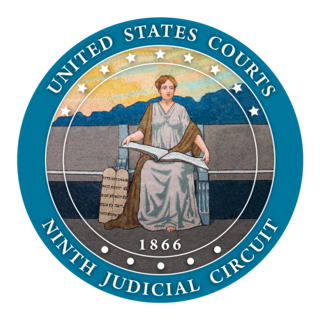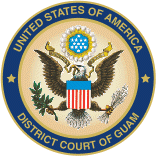Related Research Articles

The United States courts of appeals are the intermediate appellate courts of the United States federal judiciary. They hear appeals of cases from the United States district courts and some U.S. administrative agencies, and their decisions can be appealed to the Supreme Court of the United States. The courts of appeals are divided into 13 "Circuits". Eleven of the circuits are numbered "First" through "Eleventh" and cover geographic areas of the United States and hear appeals from the U.S. district courts within their borders. The District of Columbia Circuit covers only Washington, DC. The Federal Circuit hears appeals from federal courts across the United States in cases involving certain specialized areas of law.
United States bankruptcy courts are courts created under Article I of the United States Constitution. The current system of bankruptcy courts was created by the United States Congress in 1978, effective April 1, 1984. United States bankruptcy courts function as units of the district courts and have subject-matter jurisdiction over bankruptcy cases. The federal district courts have original and exclusive jurisdiction over all cases arising under the bankruptcy code,, and bankruptcy cases cannot be filed in state court. Each of the 94 federal judicial districts handles bankruptcy matters.

The United States Court of Appeals for the Ninth Circuit is the U.S. federal court of appeals that has appellate jurisdiction over the U.S. district courts in the following federal judicial districts:

The United States Court of Appeals for the Eighth Circuit is a United States federal court with appellate jurisdiction over the following United States district courts:

The United States Court of Appeals for the Second Circuit is one of the thirteen United States Courts of Appeals. Its territory covers the states of Connecticut, New York, and Vermont, and it has appellate jurisdiction over the U.S. district courts in the following federal judicial districts:

The United States Court of Appeals for the Third Circuit is a federal court with appellate jurisdiction over the district courts for the following districts:

The United States Court of Appeals for the Fourth Circuit is a federal court located in Richmond, Virginia, with appellate jurisdiction over the district courts in the following districts:

The United States Court of Appeals for the Fifth Circuit is one of the 13 United States courts of appeals. It has appellate jurisdiction over the U.S. district courts in the following federal judicial districts:

The United States Court of Appeals for the Seventh Circuit is the U.S. federal court with appellate jurisdiction over the courts in the following districts:

The United States Court of Appeals for the Tenth Circuit is a federal court with appellate jurisdiction over the district courts in the following districts:
In the United States, a federal judge is a judge who serves on a court established under Article Three of the U.S. Constitution. Such judges include the chief justice and associate justices of the U.S. Supreme Court, circuit judges of the U.S. Courts of Appeals, district judges of the U.S. District Courts, and judges of the U.S. Court of International Trade. These judges are often called "Article Three judges".

The United States District Court for the District of Utah is the federal district court whose jurisdiction is the state of Utah. The court is based in Salt Lake City with another courtroom leased in the state courthouse in St. George.

The United States Court of Appeals for the Federal Circuit is one of the 13 United States courts of appeals. It has special appellate jurisdiction over certain categories of specialized cases in the U.S. federal court system. Specifically, it has exclusive appellate jurisdiction over all U.S. federal cases involving patents, trademark registrations, government contracts, veterans' benefits, public safety officers' benefits, federal employees' benefits, and various other types of cases. The Federal Circuit has no jurisdiction over criminal, bankruptcy, immigration, or U.S. state law cases. It is headquartered at the Howard T. Markey National Courts Building in Washington, DC.
The federal judiciary of the United States is one of the three branches of the federal government of the United States organized under the United States Constitution and laws of the federal government. The U.S. federal judiciary consists primarily of the U.S. Supreme Court, the U.S. Courts of Appeals, and the U.S. District Courts. It also includes a variety of other lesser federal tribunals.
The appointment of federal judges for United States federal courts is done via nomination by the President of the United States and confirmation by the United States Senate. The tables below provide the composition of all Article III courts which include the Supreme Court and the Courts of Appeals at the end of each four year presidential term, as well as the current compositions of the District Courts and the Court of International Trade, categorizing the judges by the presidential term during which they were first appointed to their seats.

The District Court of Guam is a United States territorial court with jurisdiction over the United States territory of Guam. It sits in the capital, Hagåtña. Appeals of the court's decisions are taken to the United States Court of Appeals for the Ninth Circuit. It is not an Article III court, and therefore its judges do not have life tenure, but are appointed to ten-year terms.
Uniformity and jurisdiction in the tax decisions of the United States federal courts is the ongoing debate spanning many decades about achievement of uniformity and decisionmaking by federal courts when addressing tax controversies against the backdrop of multiple, regionally diverse courts with federal tax jurisdiction.
The Federal Rules of Bankruptcy Procedure are a set of rules promulgated by the Supreme Court of the United States under the Rules Enabling Act, directing procedures in the United States bankruptcy courts. They are the bankruptcy law counterpart to the Federal Rules of Civil Procedure.
A Bankruptcy Appellate Panel is authorized by 28 U.S.C. § 158(b) to hear, with the consent of all parties, appeals from the decisions of the United States bankruptcy courts in their district that otherwise would be heard by district courts, but only in those districts in which the district judges authorize appeals to BAPs. BAPs typically sit as three-judge panels composed of bankruptcy judges appointed from the circuit's districts, with the restriction that no judge may participate in an appeal arising from that judge's own district.
References
- ↑ "Contact Us". United States Bankruptcy Court, District of Utah. Retrieved 2024-05-09.
- ↑ "U.S. Bankruptcy Court appoints Joel T. Marker new judge for Utah". Deseret News. 2010-06-30. Retrieved 2024-05-09.
- ↑ "28 USC Ch. 6: BANKRUPTCY JUDGES". United States Code. United States House of Representatives. §152. Appointment of bankruptcy judges.
- ↑ Bates, Blaine F. (2011). "Introduction to the Bankruptcy Appellate Panel" (PDF).
- ↑ Boulden, Judith A.; Cannon, Kenneth L. "Utah Bankruptcy Practice in the Early Era, 1898-1949" (PDF). Tenth Circuit Historical Society.
- ↑ Johnson, Ezekial; Wright, James (2006). "Are Mormons Bankrupting Utah? Evidence from the Bankruptcy Courts" (PDF). Suffolk University Law Review. 40: 607.